Polls: Affirmative action a liability to women's credibility

From left: Governors Gladys Wanga (Homa Bay), Wavinya Ndeti (Machakos), Anne Waiguru (Kirinyaga) and Cecily Mbarire (Embu).
What you need to know:
- Proponents of affirmative action argue that women face unique barriers, hence deserve compensatory measures to ascend to political office.
- The often cited barriers are; llack of resources; electoral violence; male patronage in political parties; and cultural biases.
- These arguments are popular but are hardly subjected to the rigour of evidence, just as the myth that women are the majority voters.
There is palpable excitement about the performance of women in the August 9 General Election, mainly from the number of elected governors.
Seven women were declared governors-elect—in Homa Bay, Machakos, Nakuru, Embu, Kirinyaga, Kwale and Meru. This constitutes an increase of more than 100 per cent compared to 2017 when only three were elected (in Kitui, Kirinyaga and Bomet). By extrapolation, if we continue at this rate, it is only in 2047 that gender parity will be achieved in governorship.
Confirmed cases of women elected to the National Assembly stood at 28 for openly contested seats and 47 for county women representatives. This translates into 22 per cent of all members, short of the prescribed one third.
Significant is that the women elected governors and to the National Assembly open seats were not beneficiaries of affirmative action, a measure still considered by many as imperative to achieve gender balance in representation.
Proponents' argument
Proponents of affirmative action argue that women face unique barriers, hence deserve compensatory measures to ascend to political office.
The often cited barriers are: lack of resources; electoral violence; male patronage in political parties; and cultural biases. These arguments are popular but are hardly subjected to the rigour of evidence, just as the myth that women are the majority voters.
Taking resources, for example, it is a fact that political campaigns in Kenya are very expensive. But this is true for men also. Thus, anyone getting into political campaigns must have the necessary resources or the means to get them, regardless of gender.
Another fact is that many women are not poor by any standard; some are even wealthier than men. The resource question, therefore, falls flat on its face. In fact, if resources are all it takes to ascend political space, certain individuals would be in Parliament permanently, going by the depth of their pockets.
It is true that women face gender-specific forms of electoral violence, such as sexual threats and verbal slurs based on their marital status and perceived character. But electoral violence is not reserved for women. In some cases, women perpetrate violence against themselves. A case in point is where single women were challenged by fellow contestants to prove their marital status as qualification for the post of woman representative.
Male patronage of political parties is a fact. However, it is also true that women who consistently align with the party’s figurehead and bankroll the outfit get favours, just as men. This does not, nonetheless, discount the fact that some parties have shown blatant bias against steadfast women supporters.
But such women have often been vindicated when they choose alternative routes to election, as the cases of Fatuma Mohammed in Migori and Kawira Mwangaza in Meru demonstrate.
Notwithstanding these deviations, party affiliation is critical, thanks to our regional-cum-ethnic voting patterns. But again, this applies for both men and women, hence cannot be cited as an automatic dis-favour to the latter unless nominations are manipulated.
Mindsets
Cultural bias is obvious and manifests in spousal reluctance to support women’s political ambitions, heavy domestic responsibilities and moral sanctions. Nevertheless, the key issue is that leadership has been male-dominated historically, hence regarded as men’s entitlement. The challenge, then, is to change the mindsets of voters.
Talking of cultural biases reminds us of the seven women from the Kalenjin community elected into the 10th Parliament (2007–13) out of 15 female legislators. This was surprising from a community where women are culturally regarded as minors.
The wave dwindled in 2013 when only three women were elected from the community, throwing into disarray the assumption that cultural biases had died.
Losers were victims of the United Republican Party euphoria in the region. This time round, the community has elected only three women in the open National Assembly seats.
Remember that it is the Kalenjin community that elected Chelagat Mutai at 24 years of age way back in 1974, the culture notwithstanding. The conclusion, then, is that electoral cycles have unique dynamics that determine performance from one to the next.
The women elected governors and to open National Assembly seats have two common characteristics: track record and experience in political office and alignment with the most popular political party in their regions.
Thus, if women saturate political spaces, establish a track record and strategically choose parties, their chances of ascending to political offices increase, without affirmative action.
In fact, affirmative action is a liability to women’s credibility. In the 11th Parliament, for instance, beneficiaries of such action were treated as inferior politicians by both male and female colleagues.
Competing with and defeating men erases this attitude and restores the legitimacy of women in politics. This is what should be encouraged.





